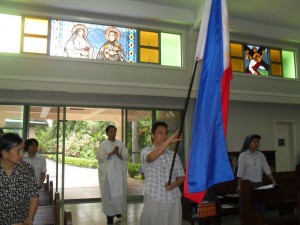 The Philippines celebrates today, June 12, its 114th independence day.
The Philippines celebrates today, June 12, its 114th independence day.
This celebration is based on the Declaration of Independence on June 12, 1898 by General Emilio Aguinaldo and Filipino revolutionary forces from the Spanish colonization. The Philippine flag was raised and its national anthem was played for the first time in 1898.
Photo: Detail from Fernando Amorsolo's The Making of the Philippine Flag
This independencse was however short-lived because Spain and the United States did not recognize the declaration.
It was only on August 14, 1964 that the annual June 12 observance of Philippine’s Independence Day came into effect after past President Diosdado Macapagal signed the Republic Act No. 4166. This Act legalized the holiday, which is based on the Declaration of Independence on June 12, 1898.

Photo: Procesional for the Eucharistic Celebration at the Good Shepherd Chapel, Quezon City, June 12, 2012.
Symbols
 The Flag of the Republic of the Philippines, representing the country is symbolized by the following:
The Flag of the Republic of the Philippines, representing the country is symbolized by the following:
Royal blue field – peace, truth, and justice.
Scarlet red field – patriotism and valor.
White triangle – equality and brotherhood.
Three stars on the corners of the triangle – the three main geographical regions of the country namely Luzon, the Visayas, and Mindanao.
The sun at the center of the triangle – has eight rays representing the eight Philippine provinces that started the revolt against Spain--Manila, Cavite, Bulacan, Pampanga, Nueva Ecija, Tarlac, Laguna, and Batangas.
The Philippines does not use a separate war flag; instead, the national flag itself is used for this purpose. The flag is unique in that it can also indicate a state of war when the red field is displayed above the blue, or on the observer's left when the flag is displayed vertically (i.e., with the white equilateral triangle at the top). In times of peace, however, the blue area is the superior field. Historical examples of this wartime reversal in orientation are during the Revolution of 1896, World War II, and some flags carried by protesters who stormed Malacañang Palace during the 1986 EDSA Revolution.
Fourteen years after the declaration of the Philippine Independence, the Good Shepherd Sisters were invited to the Philippines to open its first foundation in Batangas City. The first Irish Good Shepherd missionaries arrived in the Philippines on October 4, 1912.
